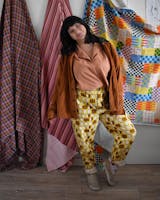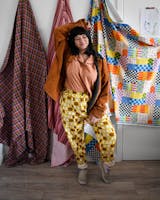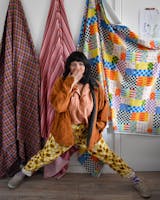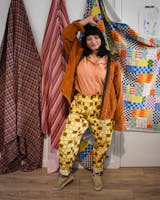As soon as I saw this pattern I knew I had to make it! I wanted a lighter coat for between seasons, with enough volume in the sleeves to go over puffed sleeve dresses and blouses. I love the casing for waist tie and the top stitching details.
It was a straightforward sew with clear instructions. The only frustration I found was that the topstitching for the cuff seam isn’t in the instructions but is indicated in the final line drawing, which I only saw after completion. I also ended up added topstitching along the hem as my lining dropped a little.
I made my coat in a medium weight chambray and cotton lining. I’m now planning another in linen and it would be gorgeous in wool for winter. Love this pattern!!!
This was probably one of the easiest sewing pattern instructions I've ever followed, nothing was left for guessing and the pictures were detailed. I love how it is a simple piece that leaves plenty of room for customization, the only limits are truly your fantasy!!
It was a gift for a friend she loves the design not used the pattern yet
Printing service from the Fold Line means you are good to go after A4 instructions printed at home.
Typical me, start with the most challenging fabric for a beginner, but I have really enjoyed making this as part of the shirt making course. Easy instructions to follow and with the video I could rewind as often as I required. Now onto the unisex shirt
Thank you so much for the free pattern. I have so enjoyed making these up this morning using some Christmas fabric. They were really clear instructions and a super easy relaxing sew and I’ve come back on site to see what other patterns there are by the same designer
I've just made three of these for the [adult] kids, who are all nearly 6 foot and want long dressing gowns, so I used the long version and lengthened by 20 cm. For some reason the back piece ends up longer than the front pieces. I found the pattern description of how to fit the collar wasn't clear but I googled other patterns and fixed it - it was how I would have guessed but not very clearly shown. I learned that my sewing machine really struggles with the multiple layers of cotton towelling - especially with interfacing - I broke more needles than I have ever done in my life; it worked much better with the bamboo towelling that my son chose compared with the cotton that the girls chose. Oddly they seem to think you don't need a loop to hang them with, but as these are heavy (thick fabric, extra long), I reinforced a section below the back of the neck with a further double layer of towelling and fitted a chain on the outside to hang them without the metal touching your skin. They were successful - I made them for Christmas but they've already been snaffled - but my children learned how extensive my swearing vocabulary can be.
This was my first attempt at shirring and the advice was really good, I'm delighted with how it turned out. I made size 20 and i was very worried that it would be too tight around the waist - something you really wouldn't be able to tell until very late in the make. However, it fits great, it is very true to size. I made it in navy suiting so it would do for work (with a top underneath). As the previous reviewer said, it stays up well, due to the tie at the back. The pattern instructions were good and it came together well.
I made a beautiful pair of these with a caramel coloured corduroy that I wore non-stop travelling in Autumn. They are comfy, stylish, and I got loads of compliments. I played with the direction of the wale on the corduroy on the side panels. Second pair in a striped yarn dyed cotton that I bought many years ago and they work just as well in a lighter fabric. I'm an advanced beginner, so stitch in the ditch was a new technique for me and really hard on my first go, so if you're using 40mm elastic, add an extra cm to the waistband as the elastic is super snug. They are also a little cropped, so add some lenghth if you're above 170cm tall.
I really like how the top turned out, it looks exactly like the pictures. It’s for sure not a beginner pattern, and benefits from some slow and steady sewing. The placket - yes it’s tricky, but doable with a bit of online help. As others have said, would be great if m&m made some tutorials. A couple of tips - if your fabric is too stiff you’ll end up with the front and back sticking out quite far from the body on an angle - think maternity silhouette. You’ll need a bit of drape. Second, the arms on m&m patterns seem to run rather narrow. Perhaps to balance out the oversized fit on the body for some styles. I’m a size 10 UK and my arms aren’t particularly large so they mostly fit, but are certainly quite snug, including on the Ellsworth. I widened them a little around the elbow.
Really loved this pattern. As a fairly un-confident beginner who had never sewn anything with a zipper before this project, I was doubtful that I would be able to finish it. But the pattern is very clear and detailed and I found myself able to actually do it! The finished product looks very professional and I can’t wait to make many more!
This is my T&T t shirt pattern. Just the right amount of ease, hangs well and looks great with a variety of jersey weights.
I chose to make this out of faux fur which was probably a mistake cos I didn't realise how slippy the material would be so it meant a lot more pins than I'd normally use! The instructions were very clear apart from when you sandwich the zip between the lining and facing as it didn't say repeat on the other side - which I know is very obvious but couldn't work it out at first. Also I personally like a lining that's not flapping around so I sewed in the dip on the bottom of the bag to secure the lining to the facing. The bag is a great roomy size and plenty big enough for a weekend away. I will definitely be making more (but not with faux fur.....)
I've had this pattern for a while, initially just downloading it then getting it A0 printed but still hung on to it while other projects took priority. Finally got round to doing a toile using Swedish tracing paper (thanks Kate for that tip).
Sadly my reservations were true and I didn't feel it was a flattering fit. Its rare I do a toile but I'm glad I did and hadn't splashed out on fabric. I felt the sleeve shape hit at the bust line and made me look bigger.
Moving on to the next project....
Just waiting to be hemmed! I made these from French Terry in a medium size.
The download from the Foldline includes a useful guide to which iterations of the pattern require seam allowances to be added. Seam allowances are included in the Foldline printout. The guide also specifies that they are 1cm. The pattern instructions did not include that information.
I like trousers to reach my waist. The rise was short. I added 5cm in the back and 3cm at the front, remembering to include the waistband and back yoke in the calculation.
It was an interesting make with the tucks in the side panels requiring careful measurement. The all elasticated waistband is easy.
I would only add that it is best to finish the straight pocket edges before sewing them on. I know it isn't actually necessary to finish jersey but it did stop the edges rolling up.
I feel very trendy.
For years I’ve been loving the Lucy and Yak style trousers and whilst I own a few pairs I am a sewist at heart and where is the fun if you can’t recreate the look yourself.
I have contemplated drafting my own over the years, but then this pattern came along and it is such a good dupe!
So far I have made myself 3 pairs and I’ve also made 2 pairs of the shorts version for my friend.
The instructions are great and the fit is perfect. I love the fitted front, elastic back view, it’s truly the best of both worlds. I have made a pair in linen, viscose linen and cotton and all the fabrics worked perfectly.
I also like that you can do just the elastic waist if you want so it’s adaptable for a range of skill sets.
I can’t recommend this pattern more, even if you’re a beginner wanting to get into sewing. I really hate sewing zips, any zips but the instructions for this were really clear and made it a painless experience. They are my go to trouser pattern when the season gets a little chillier.
Bought this to make a dress for Christmas. The pattern is easy to follow and quick to make. I did the sleeveless version and am happy with my toile and final product. I found the pattern easy to shorten and adjust based on the fabric I used as it had less drape.



































